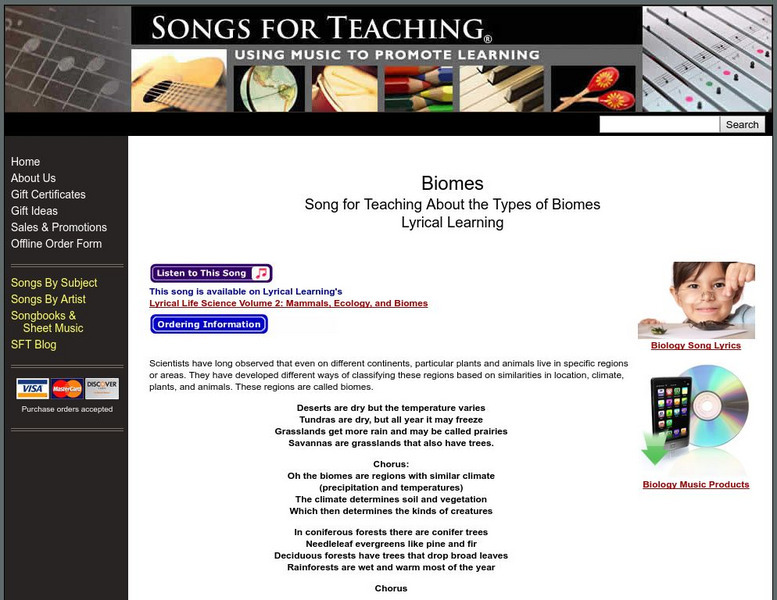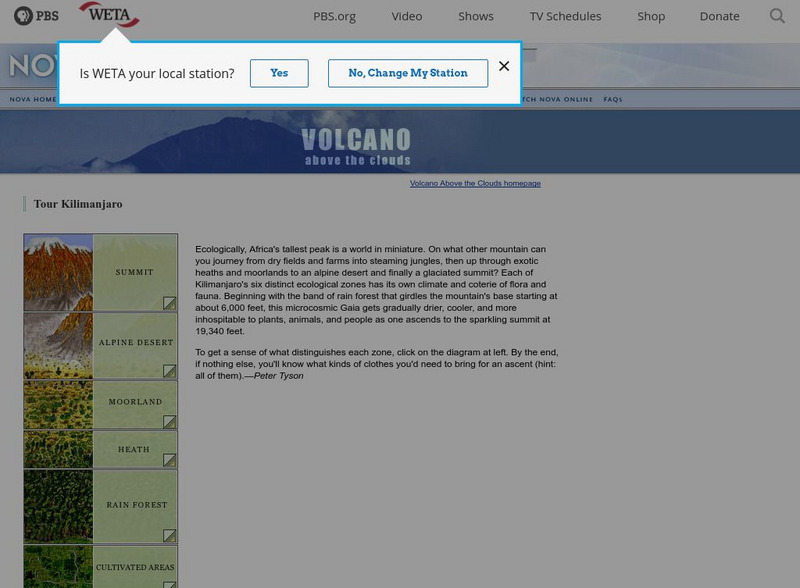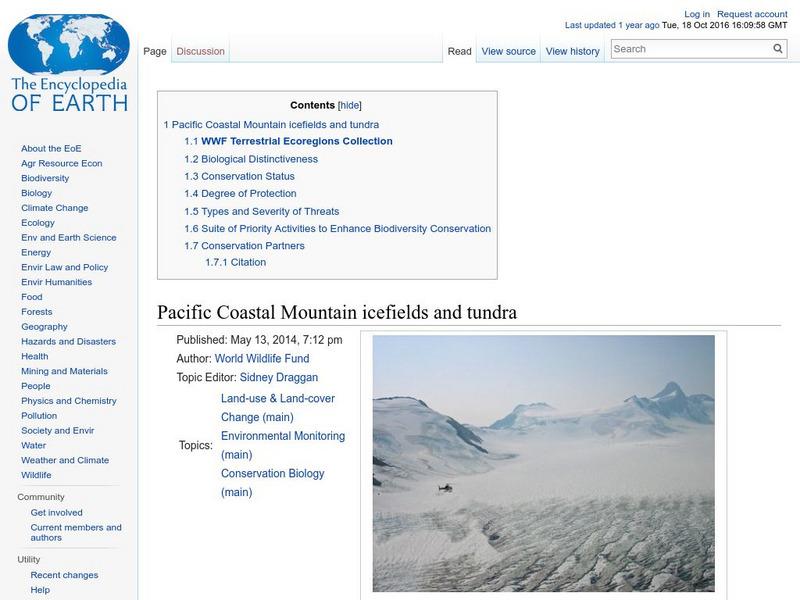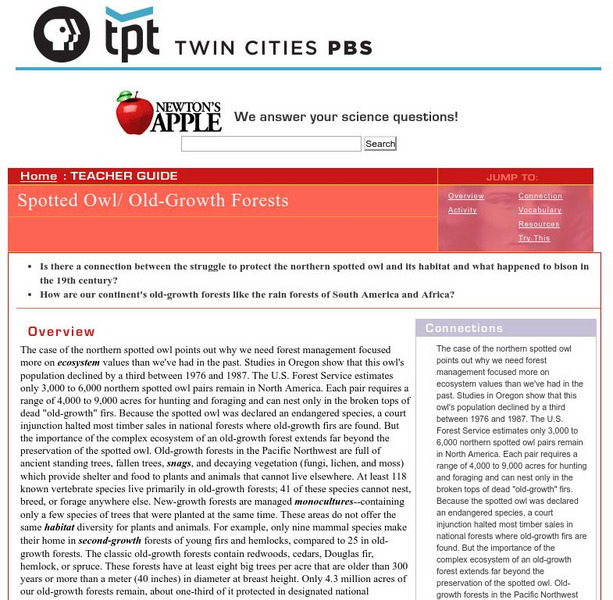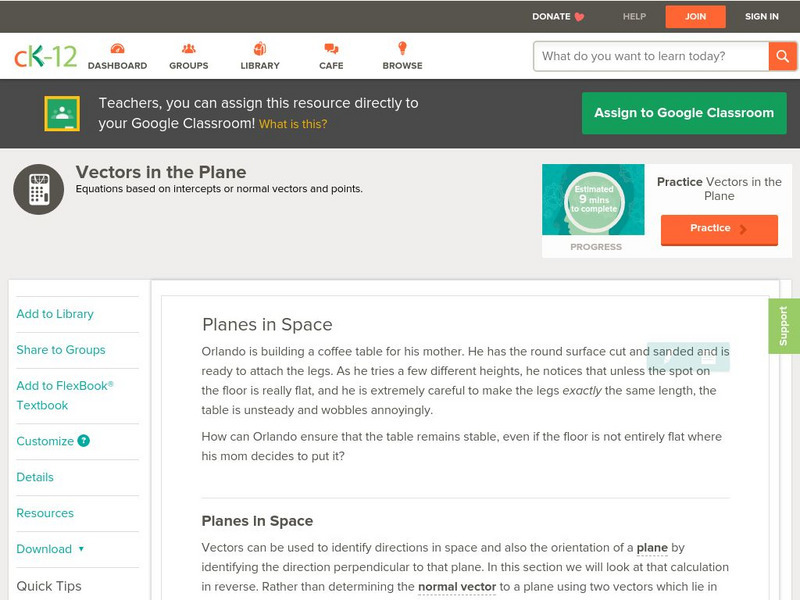Hi, what do you want to do?
Songs for Teaching
Songs for Teaching: Biomes
Use this site to see how many of the animals and plants that your students can remember from each biome after listening to this song.
Songs for Teaching
Songs for Teaching: Types of Biomes
Doug Eldon performs this great song which tells about the different biomes and their characteristics. Great way to begin your unit on the biomes.
Sophia Learning
Sophia: Terrestrial Biomes: Lesson 3
This lesson will provide an understanding of the characteristics and role of terrestrial biomes, and its effect on living things. It is 3 of 3 in the series titled "Terrestrial Biomes."
Sophia Learning
Sophia: Terrestrial Biomes: Lesson 1
This lesson will provide an understanding of the characteristics and role of terrestrial biomes, and its effect on living things. It is 1 of 3 in the series titled "Terrestrial Biomes."
Other
University of Puget Sound: World Biomes
Author provides an explanation of the term Biome and the relationship of climate, soils, vegetation, diversity, adaptations, and human effects to the biome.
CK-12 Foundation
Ck 12: Life Science: Ecosystems
[Free Registration/Login may be required to access all resource tools.] Ecology is the study of ecosystems. That is, ecology is the study of how living organisms interact with each other and with the nonliving part of their environment....
ClassFlow
Class Flow: Understanding Ecosystems
[Free Registration/Login Required] This flipchart will help students to learn about ecosystems and the living and nonliving things that interact in them.
Morning Earth
Biosphere as Place: Ocean: Benthic Biomes Two
study the Biology concept of ecosystems. The marine ecosystem tutorial comprises of definitions, pictures, and examples of an assortment of ocean benthic biomes.
Morning Earth
Biosphere as Place: Ocean Benthic Biomes One
Students investigate the Biology topic of ecosystems. The marine ecosystem tutorial consists of definitions, pictures, and examples of different ocean-benthic biomes.
Other
My Science Box: Ecosystem Organization
In this lesson, learners will learn about the different levels in the hierarchy of ecology and explain the relationships: organism, population, community, ecosystem, biome, and biosphere. They will also discover why different regions...
TeachEngineering
Teach Engineering: Environments and Ecosystems
Students explore the biosphere and its associated environments and ecosystems in the context of creating a model ecosystem, learning along the way about the animals and resources. Students investigate different types of ecosystems, learn...
Encyclopedia of Earth
Encyclopedia of Earth: Terrestrial Biome
Gives short descriptions of the many different types of biomes found on land all over the world. (Updated: February 22, 2013)
Geography 4 kids
Geography4 kids.com: Quick Look at Biomes
Check out the different types of biomes presented.
Science Education Resource Center at Carleton College
Serc: Energy Pyramids in Different Biome Locations
A research activity where learners research the various biotic and abiotic factors that combine to make up a biome. The end product will be the creation of a PowerPoint presentation that identifies these factors and the creation of an...
Other
College of Du Page: Energy in an Ecosystem
Ecosystems contain two kinds of commodities: matter (nutrients) and energy. Nutrients cycle through the ecosystem, available for repeated use by organisms. These cycles of use and reuse are called biogeochemical cycles. Energy instead is...
US Geological Survey
Lake Pontchartrain Basin Foundation: Ecosystems in Delicate Balance
Learning activities to investigate how organisms interact in a functioning ecosystem. Students will explore the role organisms play in food chains and preserving biodiversity in ecosystems. Lake Pontchartrain Basin ecosystem is featured...
PBS
Nova: Tour Kilimanjaro
Experience six different ecological zones as you climb Mt. Kilimanjaro. Pictures of plants living in each of the zones are also part of this virtual tour of the mountain.
Science Education Resource Center at Carleton College
Serc: Interdependence of Life: How an Ecosystem Responds to Change
In this biology field investigation, students will investigate the site of an environmental disturbance, identify plant and animal life within that specific area, and compare it to an adjoining forested area. Students will map both areas...
Encyclopedia of Earth
Encyclopedia of Earth: Pacific Coastal Mountain Icefields and Tundra
Describes the geography of this ecoregion, its biodiversity, its excellent conservation status, the parks and wilderness areas within its boundaries, potential threats, and organizations working to ensure its protection. (Updated August...
Houghton Mifflin Harcourt
Harcourt: School Publishers: Exploring Ecosystems
Compare and contrast three very different ecosystems - the Sonoran Desert in Arizona, the Florida Everglades, and the Arctic Coastal Plain in Alaska. Learn what makes each of them unique, and about the adaptations plants and animals had...
PBS
Newton's Apple: Spotted Owls and Old Growth Forests
This site from Newton's Apple, which is a production of KTCA Twin Cities Public Television, provides insights, vocabulary, resources and a main activity on the subject of why owls are threatened.
CK-12 Foundation
Ck 12: Analysis: Polar and Cartesian Transformation
[Free Registration/Login may be required to access all resource tools.] Converting between polar and cartesian coordinates
The Wild Classroom
The Wild Classroom: Biomes of the World: Intertidal Zone
Learn about the intertidal ecosystem. Find out about plants, animals, adaptations, and conservation efforts.
ClassFlow
Class Flow: Biomes of the World
[Free Registration/Login Required] This flipchart contains a Life Science lesson for students in grades 7-8. It was specifically designed to assist ESL students read, pronounce, and understand the meanings of key concepts presented in...






